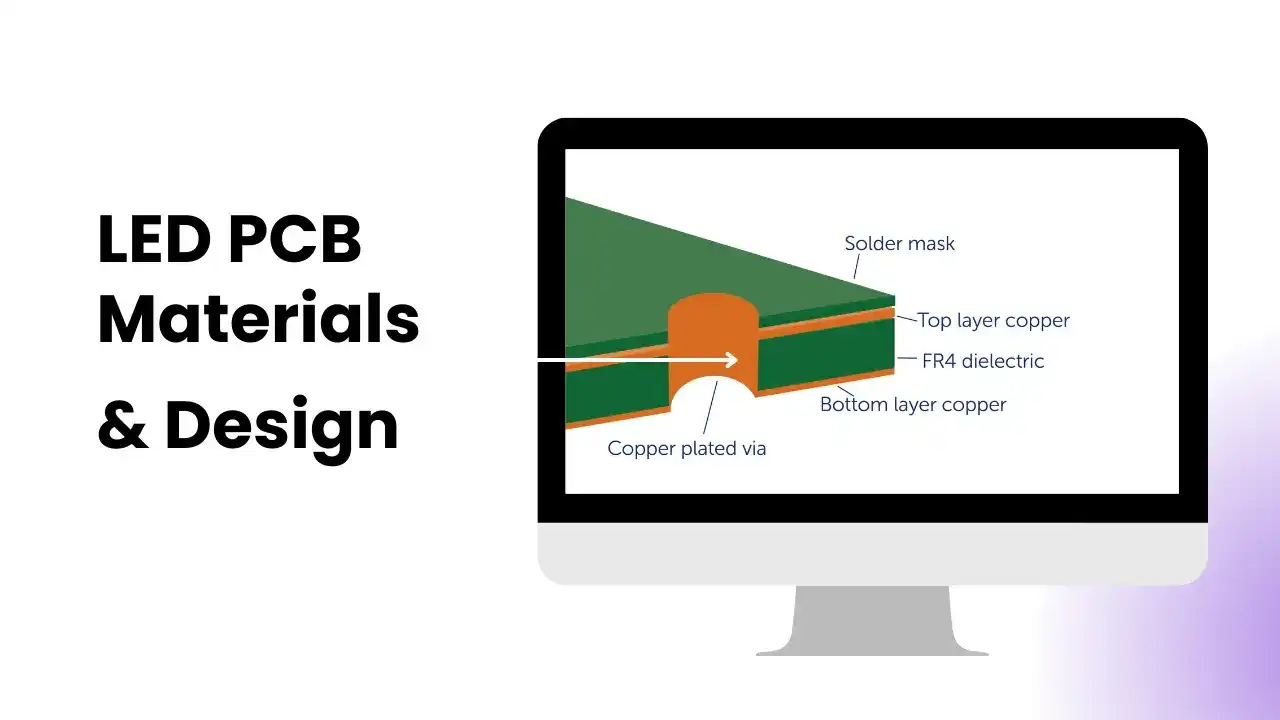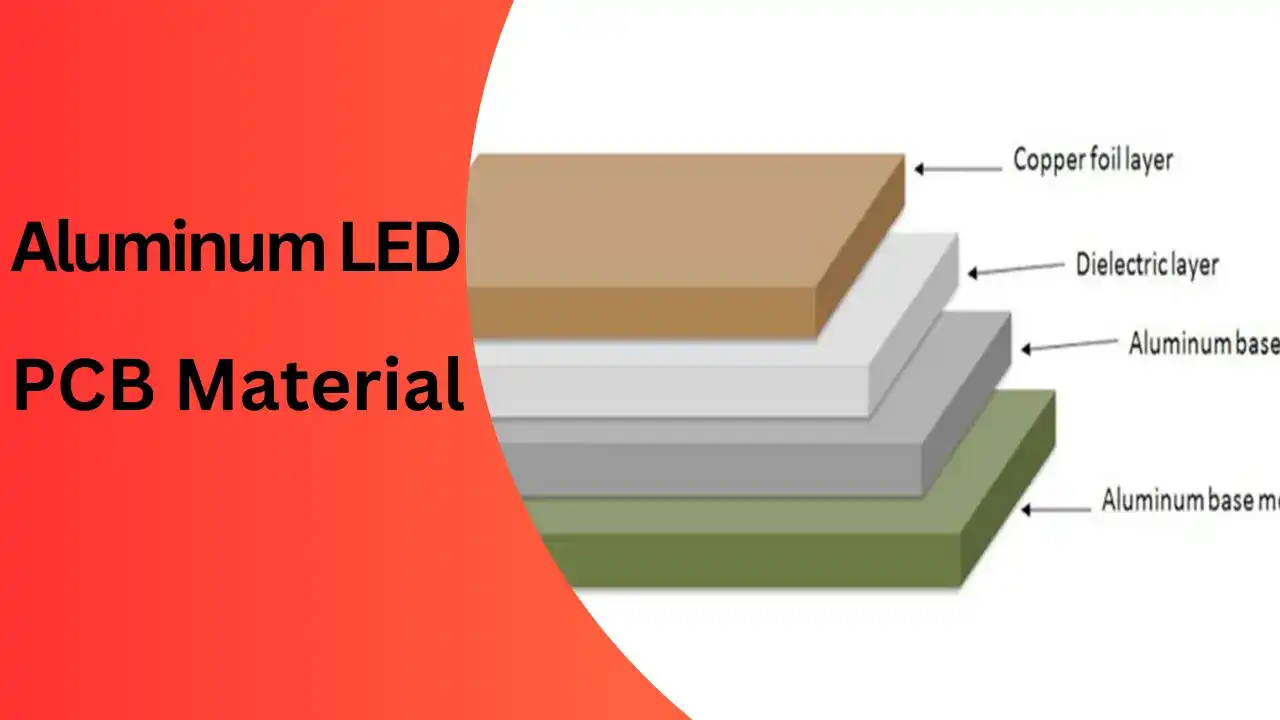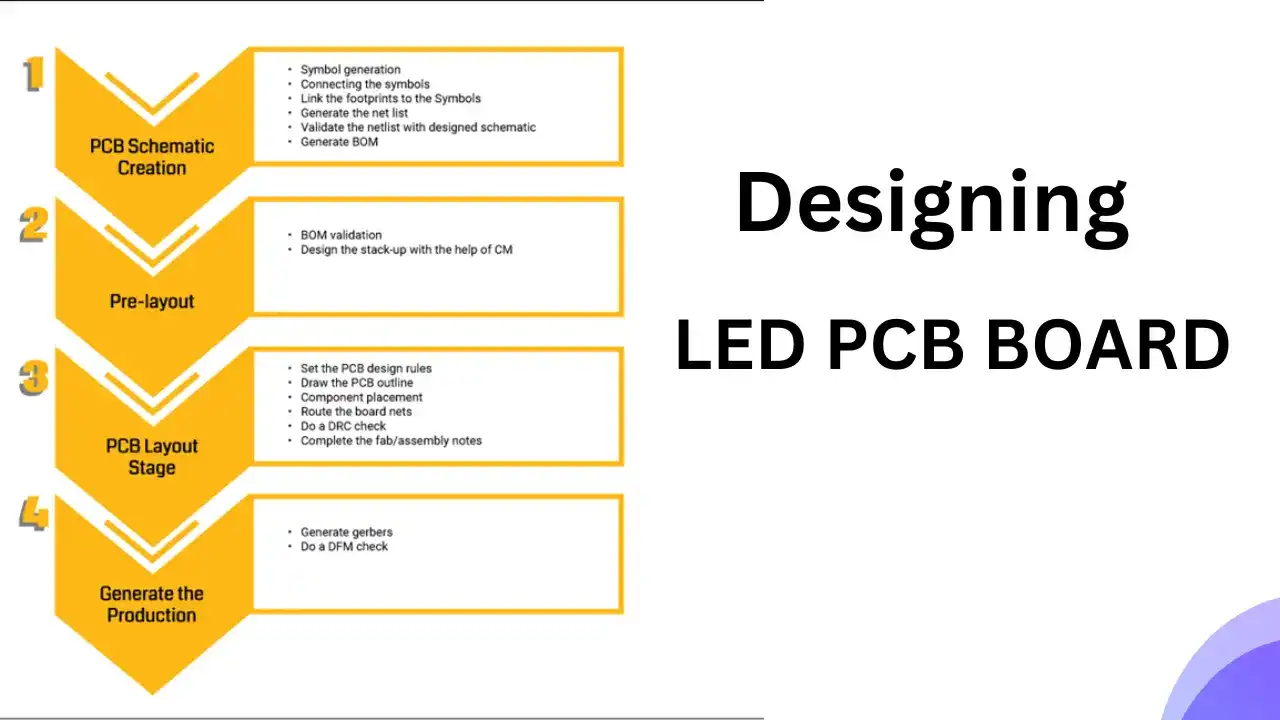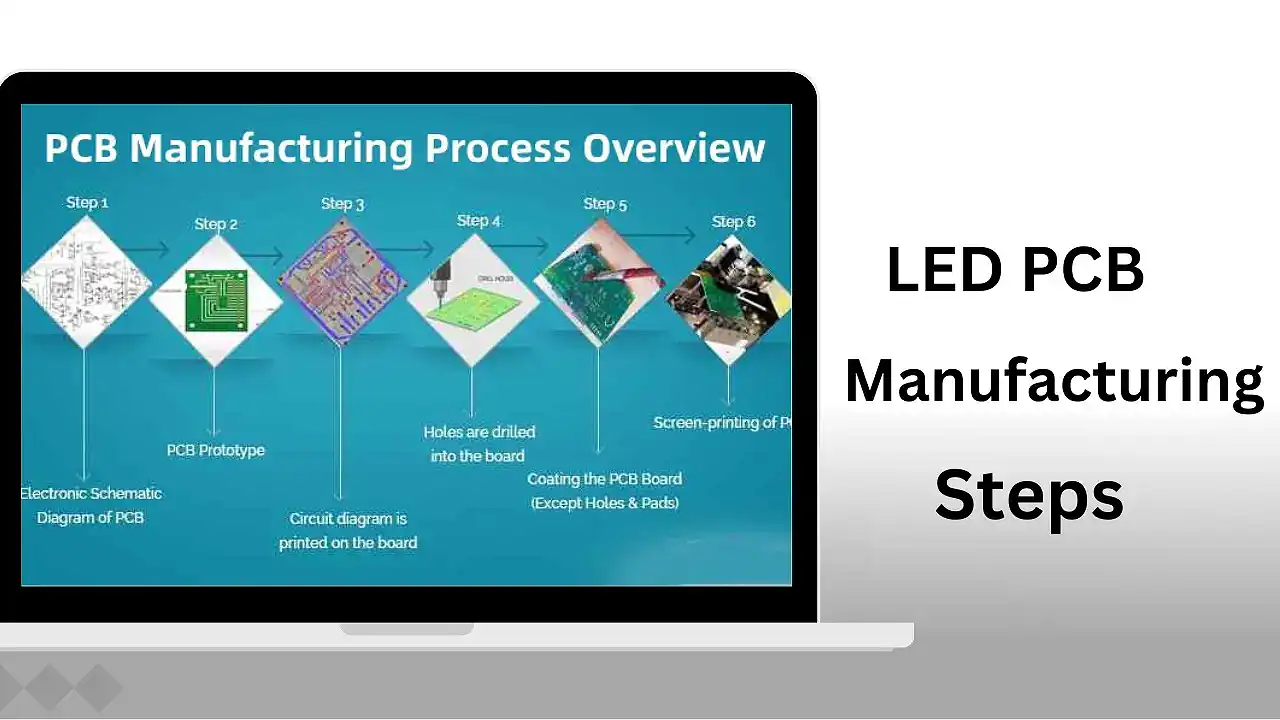LED printed circuit boards have several domestic and industrial applications. They are immensely popular due to their diverse range, performance, and life expectancy. According to a report published by Global News Wire, a valuation of US$ 179.81 billion is anticipated for the global lighting products market by 2031.
What is LED PCB made of?
LED printed circuit boards are aluminum dielectric plate that is designed to electrically and mechanically connect various electronic components. Generally, the LED circuit board material has an anodized aluminum. Based on their shape, printed circuit boards for LEDs are divided into:
- Round
- Linear
- Small size
- Rectangular
Depending on the number of layers with an electrically conductive pattern, printed circuit boards come into:
- Single sided
- Double sided
- Multilayer
According to the properties of the base material:
- Rigid (Thermally conductive)
- Flexible
LED circuit boards are necessary for multiple LED applications. For instance, they can protect the LEDs and carry heat away from the bulbs to improve their performance and efficiency.
Benefits of LED Circuit Boards
Where LED technology plays a critical role in reducing energy consumption, the role of LED circuit boards can’t be undermined. It offers several other advantages that give LED PCBs an edge over other printed circuit boards.
1. Energy Efficient:
Compared to incandescent and fluorescent lights, LEDs use significantly less energy which also decreases overall maintenance costs.
2. Compact Design:
Display LEDs, wearables, and automotive lighting are the major industries where smaller size is important. LED circuit boards not only offer compactness but also flexible design which can meet modern electronics requirements.
3. Extended Life:
As LED printed circuit boards are much more efficient than traditional bulbs, they reduce maintenance and replacement costs. Ultimately, it results in lower operating costs.
4. Excellent Heat Dissipation:
LED PCBs have excellent heat dissipation features. This feature prevents overheating and ensures optimal performance and life of LEDs.
Allows Easy Integration With Smart Technology:
Integrated LED PCBs allow some unique features such as dimming, color control, and time adjustment, making lighting more personalized for both domestic and commercial purposes.
Common Materials & Components Of LED PCB

| Material | Specification | Purpose |
| Substrate | FR-4 (Flame Retardant 4) | High-temperature resistant |
| Copper foil | Thickness: 18-35 μm | Forms circuit traces |
| Solder mask | Green, ENIG (Electroless Nickel Immersion Gold) | Protects copper traces from oxidation, |
| Silkscreen | White | Provides component labels and markings |
| LEDs | Specific type and size depending on the application | Emits light in the desired color |
| Resistors | Specific values depending on circuit design | Limits current flow to protect LEDs |
| Capacitors | Specific values depending on circuit design | Filters out noise |
| Diodes | Specific type depending on printed circuit boards design | Protects LEDs from reverse current flow |
| Transistors | Specific type depending on circuit design | Controls current flow for dimming |
| Microcontrollers | Optional, depending on the application | Provides intelligent control for complex lighting systems |
| Heatsinks | Aluminum or other heat-conductive material | Dissipates heat |
| Connectors | Headers, screw terminals, etc. | Enables connection to a power source |
Generally, a standard LED light PCB is made up of some important parts. Similarly, each part is necessary for the board to operate properly. However, the main components of LED printed circuit boards are:

1. PCB Substrate
LED printed circuit boards need a set of substrates or core materials. Selecting a substrate randomly is not an intelligent move because it affects both the mechanical and thermal qualities of the circuit board. Now let’s look at some common LED PCB board materials. All have many different kinds of uses in the LED sector.
2. FR4
FR4 PCBs are the most popular printed circuit boards substrate. It is made up of glass fiber. Moreover, FR4 is more cost-effective than many of the other substrates.
However, regarding LED PCB requirements, FR4 is not a good material for circuit boards as it has poor thermal conductivity. Therefore, it makes heat dissipation more difficult and raises the risk of problems like heat damage to the circuit board and components.
3. CEM-1
CEM-1 is quite similar to FR4. Moreover, a single-layer circuit board is necessary for many LED circuits. CEM-1 performs well as a material, offering an equilibrium between PCB cost and thermal conductivity.
4. CEM-3
CEM-3 is an excellent alternative to FR-4 and is a member of the same family as CEM-1. Furthermore, CEM-3 has better mechanical strength than FR-4, which makes it convenient to handle physical loads and gives the circuit outstanding support.
5. Aluminum PCB Material
Aluminum is one of the most widely used metal-based substrates. Similarly, copper and aluminum have similar thermal conductivity values.
Aluminum also endures strong currents as well as mechanical and thermal stress. Aluminum is the most popular material for LED PCBs because of its superior heat dissipation and power handling properties.

6. Copper Traces
Copper is often used to create traces on LED-printed circuit boards. The main advantage of copper is its outstanding conductivity.
This proves that it can transmit signals with ease and maintain power during the process. The circuit’s conductive paths enable current to travel between the LEDs and all other parts.
7. Solder Pads
The solder pads of a printed circuit board handle the pins of essential parts, such as chips and transistors. Solder pads are small copper pads used as mechanical supports to enable the soldering of components to the board. In addition, they act as a barrier of protection. Furthermore, they protect the copper traces from outside factors and stop short circuits by shielding them.
8. Resistors
Resistors are commonly utilized in circuits to control the current flowing to other parts of the electrical system. Similarly, a resistor is a device that resists current flow. When a resistor adds up to a circuit, the total amount of current that flows through it reduces.
9. Capacitors
Capacitors are vital parts of electronic systems. Similarly, capacitors’ main function is to maintain electrostatic energy in an electrical field and release it into the circuit when needed. Furthermore, they enable AC to flow but prevent DC from flowing to prevent a hazardous circuit breakdown.
Types of LED PCBs
LED printed circuit boards are available in several types. Multiple types of LED PCB boards are available, depending on the material, usage, and manufacturing requirements. We have mentioned some prominent types of LED PCB board:
Also Read About Types Of Printed Circuit Boards
Single Layer Vs. Multilayer PCBs
Single-layer PCBs are the most common kind of board, with components placed on a single side. Similarly, many boards also have a substrate layer. However, this board only has one conductive copper layer.
Single-layer PCBs are cheap and have a simple design. As a result, they don’t need any complex technical processes to make.
This is because it provides a simple design that makes the manufacturing process very simple.
Multilayer boards can have more than three layers, depending on the requirements, and have components installed on both sides.
The layers come on top of each other. Similarly, this type of boards consists of a prepreg layer, a copper-coated layer, and a core layer.
Multilayered printed circuit boards have complex designs and LED PCB board manufacturers manufacture these boards following customers’ requirements. Of course, multilayer boards are stronger than single-layer ones. Furthermore, they are robust against high temperatures and severe environments like factories.
Flexible LED PCB
The name says everything. It comes from malleable materials and can bend in many ways. Moreover, it has layers in single, double, and multilayer types. Similarly, the cost of printing a circuit on flexible material is a bit higher.
A flexible LED PCB board has greater benefits than a rigid LED PCB.
Rigid LED PCB
Rigid printed circuit boards are very different from the flexible ones. It is made of solid material. It is found on the computer. Additionally, it comes with multiple layers.
Aluminum-based PCBs
Aluminum LED light PCB is a special kind of copper-clad laminate with excellent electrical insulation and heat dissipation efficiency. It has become the most popular metal core PCB due to its many advantages.
Metal Core PCBs (MCPC)
MCPCBs LED printed circuit boards use a metal core such as copper, aluminum, or stainless steel. This metal core is a heat sink, effectively transferring and dispersing heat generated by PCB components.
Design Considerations for LED PCBs

Several factors play a pivotal role during the design process of LED light PCB. These include:
- Heat Dissipation:To prevent LED overheating, which can result in reduced brightness, color shift, and even LED failure, LEDs produce heat during operation. To ensure LEDs function at optimal temperatures, proper heat sinking and thermal management strategies are crucial.
- Current Regulation: To ensure consistent performance and increased LED life, drivers must regulate the current flow properly so as not to damage the LED core. Exceeding the LED’s recommended current rating will result in damage, so precise current regulation is essential.
- Layout Optimization:When designing LED light PCB, you must place LEDs, components, and traces strategically to maximize their efficiency and functionality:
- Minimize power losses
- Ensure proper heat dissipation
- Optimize signal integrity
- Extend space use
- LED PCB assembly process is easy
Careful layout optimization can significantly improve the performance of your LED light PCB.
- EMC Compliance:It is important in the design of LED printed circuit boards to implement shielding, filtering, and grounding techniques to comply with EMC regulations and prevent interference.
- Software Considerations:A PCB design must include access to software interfaces and communication protocols for LED applications that involve features such as:
- Dimming
- Color change
- And customization.
Tips To Note In LED Printed Circuit Board Design
Display the Polarity:
Display the direction of the LED with silk printing so you don’t get confused when soldering parts. Draw the circuit symbol for the LED or mark the cathode.
Consider Placement
As mentioned above, LEDs are sensitive to heat, so place them away from components that generate heat. Also, be careful not to place tall parts nearby as visibility will be poor.
Mounting Height
LEDs with leads can be soldered slightly above the board. If you want to lift it off the board, a special spacer is often used, so consider this when designing.
Consider The Color Of The Resist
When using LEDs for purposes such as lighting, a white resist may be used, taking into account the efficiency of reflection from the substrate. On the other hand, if you want to minimize reflection, you can also choose black.
Heat Dissipation
As mentioned above, high-output LEDs generate a large amount of self-heat. Additionally, current-limiting components also generate heat when large currents flow through them. Furthermore, it is necessary to dissipate heat by creating a sufficient heat dissipation pattern.
Manufacturing Process for LED PCBs

Creating an LED PCB involves several crucial steps, similar to building a complex puzzle. Here’s a simplified overview:
- Design and Layout: Like building a blueprint, this stage involves meticulous planning and designing the PCB’s layout, including the positioning of LEDs, components, and electrical pathways.
- Photolithography:Imagine shining a light through a stencil onto a sensitive film. This process uses light to pattern the desired copper circuit traces onto the PCB surface.
- Etching: Just like carving away unwanted material, etching uses chemicals to remove the copper not covered by the photoresist film, leaving behind the desired circuit traces.
- Drilling: Tiny holes are drilled into the PCB at specific points to allow components to be securely attached.
- Soldering: This involves melting a special metal alloy to create permanent electrical connections between the components and the copper traces.
- LED PCBAssembly and Testing: Finally, all the components are carefully mounted onto the PCB and soldered in place. The completed PCB then undergoes rigorous testing to ensure its functionality and performance.
Think of these steps as assembling a puzzle: each piece plays a crucial role in creating functional LED printed circuit boards.
Types of LEDs with SMD Mounting Type
SMD LEDs vary in several characteristics, including:
- Number of crystals placed in the case;
- Standard sizes;
- Highest current strength;
- Heating temperature;
- angle of propagation of the light flux.
When choosing light-emitting semiconductor devices, their power, color, and brightness are taken into account. Single-color, two-color, and multi-color LEDs with SMD mounting type are available. Similarly, white LEDs vary in color temperature, from cool white to warm yellow light.
Applications of LED PCBs
We can find LED PCBs in different industries, ranging from lighting our homes to powering our high-tech devices! Here are some common applications of LED PCBs:
- Lighting Fixtures: Light sources using LED PCBs are energy-efficient, long-lasting, and come in vibrant colors.
- Electronic Devices: From smartphones and tablets to laptops and wearables, LED PCBs power displays, backlights, and indicators, enhancing user experience and functionality.
- Automotive Applications: LED PCBs are behind the bright headlights, taillights, and instrument panels of modern cars, contributing to safety and visual appeal.
- Medical Equipment: From diagnostic instruments to surgical tools, LED PCBs provide precise illumination in critical medical applications, ensuring accurate diagnoses and optimal patient care.
- Consumer Electronics: From TVs and gaming consoles to cameras and smart speakers, LED PCBs enable vibrant displays, intuitive interfaces, and exciting features.
- Signage and Displays: From advertising billboards to retail displays and digital signage, LED printed circuit boards offer captivating visuals that grab attention and communicate effectively.
LED PCBs are moving toward innovation in terms of performance. For instance, we need to do a lot of work on heat-resistant design and materials. Ultimately, it will improve the product quality and efficiency.
Conclusion
LED printed circuit boards are expanding to different industries. Since it provides excellent characteristics such as color choice, size, and performance, LED circuit board is in high demand. Similarly, we can witness the latest demands of smart LED circuit board which provides a more personalized experience.
